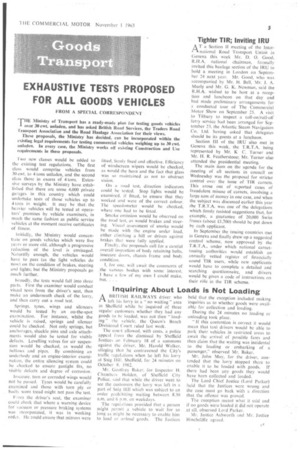EXHAUSTIVE TESTS PROPOSED FOR ALL GOODS VEHICLES
Page 7

If you've noticed an error in this article please click here to report it so we can fix it.
FROM A SPECIAL -CORRESPONDENT • THE Ministry of Transport has a ready-made plan for testing goods vehicles I over 30 cwt. unladen, and has asked British Road Services, the Traders Road transport Association and the Road Haulage Association for their views.
These proposals, the Ministry has decided, can be incorporated within the existing legal requirements for testing commercial vehicles weighing up to 30 cwt. unladen. In every ease, the Ministry works off existing Construction and Use requirements in these proposals.
Two new classes would be added to the existing test regulations. The first class would comprise vehicles from 30 cwt. to 4 tons unladen, and the second class those in excess of 4 tons. Extensive surveys by the. Ministry have established that there are sonic 4,000 private garages in this country which could undertake tests of those vehicles up to 4 tons in weight. It may be that the heavier vehicles will be tested at operators' premises by. vehicle examiners, in much the same fashion as public service vehicles at the moment receive certificates of fitness, Initially, the Ministry would concentrate on goods vehicles which were five years or more Did, although a progressive reduction of the level is envisaged. Naturally enough, the vehicles would have to pass (as the light vehicles do now) on the condition of brakes, steering and lights; but the Ministry proposals go much further.
broadly, the tests would fall into three parts. First the examiner would conduct visual tests from the driver's seat, then make an underneath check of the lorry, and then carry out a road test.
Springs. tyres, wings and silencers would he tested by an on-the-spot examination. For instance, whilst the vehicle is raised, springs and silencer could be checked. Not only springs, but anchorages, shackle pins and axle attachments would also be tested for visible defects. Levelling valves for air suspension would be checked, as would the bellows and pipes. By combining an underbody and an engine-interior examination, the entire silencing system could he checked to ensure gastight fits, no visible defects and degree of corrosion.
Insecure, torn or corroded wings would not be passed, Tyres would be carefully examined and those with torn ply or badly worn tread might not pass the test.
From the driver's seat, the examiner could cheek that where a warning device for vacuum or pressure braking systems was incorporated, it was in working order. He could ensure that mirrors were fitted, firmly fixed and effective. Efficiency of windscreen wipers would be checked, as would the horn and the fact that glass was so maintained as not to obstruct visio n.
On a road test, direction indicators could be tested. Stop lights would be examined. if fitted, to ensure that they worked and were of the correct colour. The speedometer would be checked, where one had to be fitted.
Smoke emission would be observed on the road test, as would brakes and steering. Visual assessment of smoke would be made with the engine under load, either climbing a hill or driven against brakes that were fully applied.
Finally, the proposals call for a careful overall inspection of body retaining bolts, insecure doors, chassis frame and body_ condition.
1, for one, will await the comments of the various bodies with some interest. I have a few of my own I could make, but. . .




































































































